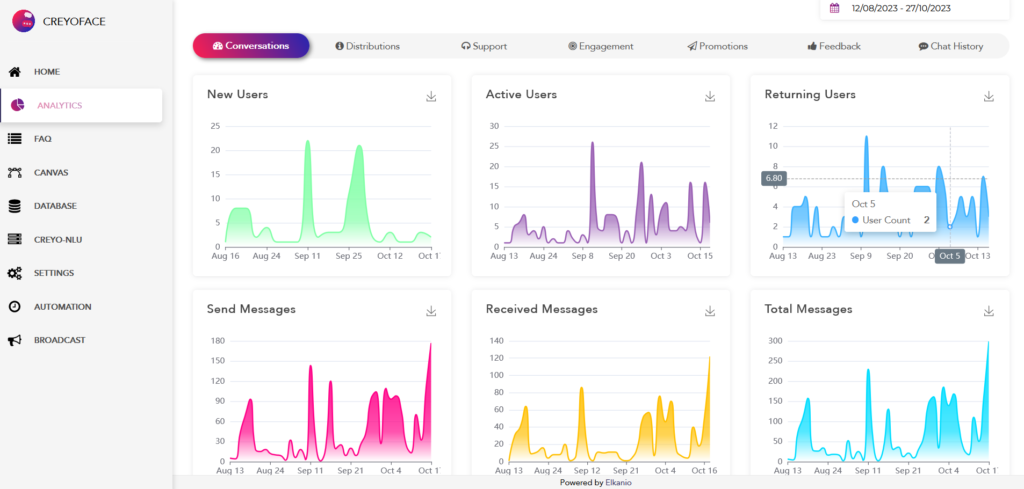Are you curious about the hype behind conversational marketing and how it can promote your online sales?
Conversational marketing enhances user interactions and drives sales on your website.
In this guide, we’ll break down all you need to understand about this approach.
Introduction
Let’s imagine a scenario here. Martin plans a quick trip for his anniversary. He browsed the growing travel agency Skyline Holiday’s website. A scenic European tour caught his eye, but he wondered about couple-specific activities and vegetarian dining options.
Hoping for quick clarity, Martin looked for a chat option but only found a “Leave a Message” box. Not willing to wait, he went to another agency, Paradise Travel Agency, where a chatbot quickly helped. Within minutes, he got his answers and a special anniversary package deal. By evening, Martin had secured his trip with them.
Do you want this to happen to your Business?
If not, adopt conversational marketing into your business operations.
This article will discuss conversational marketing and its impact on brands.
What is Conversational Marketing?
First, Let’s understand the idea of conversational marketing.
Conversational marketing is about chatting with your customers online, just like in a store. It turns chats into chances, making every online conversation personal and purposeful. Moreover, it’s about listening to your customers in real-time, guiding them closer to what they seek, and finishing online shopping feel as natural as a friendly chat.
Let’s explore some facts you need to know about conversational marketing.
- Conversational marketing introduces a chat element to your current marketing efforts.
- Chatbots are the optimized way for a conversational approach. They engage with customers, offering guidance when needed.
- In this method, you don’t always need someone to answer every query.
- Conversational marketing allows seamless integration with CRM systems.
Are you ready to make your marketing more conversational? Come, Let’s dive in deep.
Why Conversational Marketing?
Conversational marketing has become the go-to strategy to engage customers and increase sales.
The name tells a lot about the term, but if you’re curious why it’s important, enjoy reading further!
Personalized Interactions
Conversational strategy lets comapnies engage personally with customers. It helps to improve customer satisfaction. 9 out of 10 customers expect brands to respond quickly.
Scalability
Companies can talk to many customers using tools such as chatbots without needing a human agent. It helps to improve scalability.
Real-Time Responses
When brands use conversational ways, they can quickly answer questions. It helps them to attract new customers and sell more products.
Building Relationships
Conversational marketing is excellent for creating connections with potential and current customers. Moreover, it makes the brand seem more friendly and can lead to more people becoming customers.
Insights into Customer Behavior
It also helps comapnies understand what their customers like to buy and can help them figure out what might sell more in the future.
Know Your Customers
Conversational marketing lets brands get to know their customers better. When customers chat with an AI bot, it learns about their likes, dislikes, and how they shop. Also, this information can be used to create a unique profile that makes the shopping experience more personal.
Get More Leads
Conversational approach helps brands get more potential customers interested. People often don’t like filling out forms, so using a chatbot to talk to them keeps the conversation alive and helps guide them toward becoming a lead.
Round-the-Clock Availability
Chatbots remain online even when your business doors close, offering 24/7 assistance. Also, they play a vital role in enhancing customer service by managing customer queries quickly.
Improving Campaign Effectiveness
Using WhatsApp chatbots as part of your marketing campaigns is a smart move to boost conversion rates. Moreover, linking chatbots to your calls-to-action (CTAs) makes the customer experience more personal.
For example. Let’s picture a scenario. Jim, a sneaker fan, was browsing Instagram when he spotted an ad from your brand. He will automatically be taken to your Whatsapp bot when he clicks on the ad. Also, you will get the important information of Jim, and you will get a potential customer. Thus, you can send messages to Jim anytime – a life long hook.
Look at the image below to understand this event’s flow.

How to Implement Conversational Marketing?
We have discussed the outline and the need for conversational marketing. Now, let’s explore the different ways to implement it.
Chatbots
Chatbots are digital tools that imitate human conversations using natural language processing (NLP) and machine learning (ML) techniques. Also, they automate business operations like customer support, and sales.
Live Chat
Live chat is a real-time communication system that enables companies to engage with their customers directly through their websites or other platforms. Moreover, it is used in customer service, sales queries, and marketing activities.
Moreover, there is also a hybrid method of communication where chatbots and live chat work together to assist customers. Initially, the chatbot handles customer conversations, answering common queries. If a complex issue arises or the customer prefers human agent, the chatbot transfers the conversation to a live agent.
SMS
SMS offers a simple text messaging medium ideal for a conversational approach. Also, SMS helps companies to engage with their audience, appropriate for promotions, support, and sales goals.
Social Media Platforms
Platforms like Facebook Messenger, Instagram, and Twitter can be used for conversational marketing. Moreover, companies can connect instantly with their customer through these mediums, providing personalized interactions.
Voice Assistants
Using voice assistants like Siri, Alexa, and Google Assistant introduces a new dimension. Moreover, these tools allow companies to offer better experiences to users via voice interactions.
WhatsApp Chatbot
WhatsApp businesses and bots are critical players in conversational marketing. Moreover, businesses can simplify their promotional efforts with its unique features like product catalogues, broadcast functions, and pre-set message templates.
How to Use Chatbots for Conversational Marketing
Here are Some ways you can use chatbot marketing for your business.
Lead Generation with Chatbots: Chatbots can be set up to chat with each website visitor while gathering important information. Also, it helps brands to streamline the lead collection process.
Conversational Sales Campaigns for Social Media: Businesses can run chatbot-driven campaigns on platforms like Facebook or Twitter to engage users in real-time conversations instead of traditional ads.
Hybrid Chatbots on E-commerce Websites: Chatbots can also work with human agents using the live chat feature. They handle routine queries while leaving more complex issues to humans.
Moreover, human agents can use the spectate feature to monitor the conversations between a chatbot and a customer. Thus, they can take over the conversation whenever required.
Conversational Landing Pages: Instead of static landing pages with text and images, businesses can design pages where chatbots immediately engage visitors in a conversation, guiding them through product offerings or collecting feedback.
Also, interactive engagement can result in more long page visits. It’s an excellent way to address potential customer queries.
Conversational Marketing Trends
We have covered the important things you need to know about conversational marketing. Let’s explore some future Conversational marketing trends.
Consolidation of Marketing Products: In 2024, marketing tools will be separate for specific tasks or big platforms connecting with existing tech.
Conversational AI: Conversational AI is expected to be more popular as it provides personalized customer conversation. Moreover, it reduces customer service costs.
Speech-Based and AI-Powered Messaging Apps: Regular mobile and web apps will soon replace voice and AI-powered apps.
Data Privacy: People are more worried about their data. So, companies must be transparent about what they do with customer information.
Personalized Content Experiences: Businesses will provide more personalized experiences for their customers using the power of data analytics and AI.
Social Media Stories: Brands will use social media stories even more to engage with the audience effectively.
Voice Search Optimization: More people will talk to voice assistants such as Siri, Alexa, and Google Assistant.
Augmented Reality: Brands will likely use augmented reality more in their promotions, aiming to offer fun and freindly experiences to their customers.
Best Practices for Conversational Marketing
1. Defining Business Goals and Metrics
Before you begin conversational marketing, think about what you want to achieve. Fix your priority first. It may be boosting sales through social media through Facebook or increasing customer happiness.
2. Identify Key Message Points
Conversational marketing centres on effective communication. Imagine yourself as the customer and think about what interests you most. A special offer for a new product with an offer code or an opportunity to access free content in exchange for your email address. Keeping the message brief and focused on one central point is crucial.
3. Choose the Communication Channel.
Select the communication channels you want to use for conversational marketing. You can use email, website, or social medias like Facebook, WhatsApp, etc. But remember your purpose before selecting the channel.
For example, Facebook Messenger may be perfect if you aim to provide product suggestions. Consider using a chatbot on your website to address customer queries about the product.
4. Create a Personalized Customer Experience
Personalization is critical in conversational marketing. Moreover, personalized conversation helps to maintain good relationships with your customers.
5. Use the Right Data and Better Analytics
Making the right decisions starts with the correct data. Regarding conversational marketing, using proper data and better analytics can help you understand your customers better.
For example, the preface has an analytics page in the canvas. Here, businesses can get an overview of the interactions.
Given below is the image of Creyoface’s analytics page.

6. Focus on Customer Engagement
Conversational marketing improves customer bonds, enhancing engagement and loyalty. By interacting with customers humanly, you can create a unique connection they may not have met with a brand before.
Moreover, these conversations create a sense of comfort for users, allowing you to gather valuable customer insights and better understand potential leads.
7. Set Up an Analytics Tracking System
You should ensure that you have a system to store all chat logs and data from potential and existing customers. Chatbots connect with marketing automation and CRM platforms and offer analytics for tracking.
Your marketing team should utilize this data to assess the effectiveness of their conversation starters and identify areas for improvement based on the insights collected.
8. Create Different Dialogues for Each Customer Type
If your brand has different customer types, ensure each gets content designed just for them. Also, your website should offer customized conversations tailored to specific groups for each product or service section.
The way to do this is by gathering data from outside your website to help visitors pick the category that suits them best. Then, guide them to the content most relevant to their needs.
9. Identifying the best web Pages and Digital Tools available
Find your most popular web pages and digital tools. When implementing your conversational marketing strategy, focus on these pages and deploy chatbots strategically.This aims to provide engaging, personalized experiences to first-time visitors and guide them toward content that drives conversions.
10. Provide Convenient Self-Service Options
Give your customers control over their content preferences, including videos, blogs, FAQs, marketing resources, and contact centre details. Moreover, incorporating self-service options into your conversational marketing approach boosts customer happiness and smooths the sales process by avoiding hurdles.
Conversational Marketing Examples
Conversational marketing is a new approach companies adopt to engage with their customers more immediately and personally.
Instead of relying on traditional, one-size-fits-all marketing strategies, conversational marketing uses the power of real-time dialogues and interactions.
Moreover, the main idea is to “converse” with customers, meeting them where they are and guiding them through their buyer’s journey.
Let’s delve into some examples of conversational approach across different sectors.
H&M
H&M has adopted a conversational commerce approach, enabling customers to converse with sales representatives instantly, seek answers, and get tailored recommendations. They implemented a chatbot called Kik to assist their customers. It helps make shopping more personal and can lead to upselling.
Sephora
The global beauty brand Sephora uses a virtual artist feature in the Facebook messenger bot as a conversational tool to increase sales and brand loyalty. Moreover, this advanced AR feature lets the brand’s customers virtually test makeup by uploading photos and experimenting with various lipstick colours, eyeshadows, and false eyelashes.
Gerber
Gerber is an American baby product company. They developed the “My Feeding Finder” tool to help new parents select the right formula for babies. Considering the target audience’s limited time, they’ve made the process simple and efficient.
Natori
Natori, an online store selling stylish clothing and home items, actively uses Facebook Messenger. Also, Natori’s quick replies on Facebook Messenger show how a brand can use social media to enhance customer experience.
Kettlebell Kings
Customer service is important for any business, especially for a company like Kettlebell Kings that sells kettlebells. They’ve improved customer support by a chatbot on their website and Facebook page. Moreover, this chatbot assists visitors and encourages them to register for their workout service.
American Leather
American Leather focus fast delivery and personalization. They don’t think customers should wait more than ten weeks for customized furniture. They’ve got a chatbot named AL that assists customers before and after buy.
Do these brand success stories inspire you to consider your conversational commerce approach?
Integrating a conversational approach can make a difference if you have a B2C brand.
Conclusion
We have explored the basics of conversational marketing and how it can benefit your business.
Let’s recap what we have discussed in this article.
- The outline and some facts about conversational marketing
- The need for conversational marketing and how it helps companies.
- The different ways to implement conversational marketing
- The future trends of conversational marketing
- Some best practices that should be included in your conversational marketing
- Real-life examples of Conversational marketing
Since the conversational marketing approach is gaining more popularity, ensure you don’t miss out on this opportunity. And don’t worry about the tech side.
You don’t need to be a programmer to start your conversational journey. We have a no-code tool creyoface for creating a conversational marketing strategy.
If you are ready, sign up, and we will take it up from there.
Ready To Explore?
Frequently Asked Questions?
What is conversational marketing?
It is an approach that uses real-time conversations to engage and interact with customers. Moreover, it focuses on personalized, interactive, and two-way communication to build relationships, provide information, and drive customer engagement.
What role does live chat play in conversational marketing?
Live chat enables real-time, one-on-one conversations between businesses and customers. Also, it allows companies to answer questions, address concerns, and provide immediate support, leading to higher customer satisfaction and better conversion rates.
How can conversational marketing be personalized?
It can be personalized by leveraging customer data and preferences. Moreover, businesses can tailor conversations, recommend relevant products or services, and provide customized support by integrating with customer relationship management (CRM) systems or using data from previous interactions.
How can conversational marketing improve lead generation?
It provides an opportunity to engage with leads in real-time and guide them through the buyer’s journey. Businesses can nurture leads and increase conversion rates by offering personalized recommendations, answering questions, and addressing concerns.








